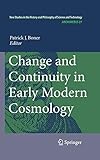Change and Continuity in Early Modern Cosmology / edited by Patrick J. Boner.
Tipo de material: TextoSeries Archimedes, New Studies in the History and Philosophy of Science and Technology ; 27Editor: Dordrecht : Springer Netherlands, 2011Descripción: xii, 181 páginas recurso en líneaTipo de contenido:
TextoSeries Archimedes, New Studies in the History and Philosophy of Science and Technology ; 27Editor: Dordrecht : Springer Netherlands, 2011Descripción: xii, 181 páginas recurso en líneaTipo de contenido: - texto
- computadora
- recurso en línea
- 9789400700376
- D1-DX301
Springer eBooks
1. Acknowledgments -- 2. Notes on Contribtutors -- 3. Introduction -- 4. The Reality of Peurbachs Orbs , (Barker) -- 5. Continuity and change in cosmological ideas in Spain between the sixteenth and seventeenth centuries, (Navarro Brontos) -- 6. Cornelius Gemma and the new star of 1572 ,(Tessicini) -- 7. Johannes Kepler and David Fabricius: their discussion on the nova of 1604, Grandada -- 8. Kepler’s copernican campaign and the new star of1604 , (Boner) -- 9. From cosmos to confession: -- Kepler and the connection between astronomical and religious truth, (Rothman) -- 10. Johannes phocylides holwarda and the interpretation of new stars in the dutch republic, (Vermij) -- 11. Discovering mira ceti:celestial change & cosmic continuity, (Hatch).
Viewed as a flashpoint of the Scientific Revolution, early modern astronomy witnessed a virtual explosion of ideas about the nature and structure of the world. This study explores these theories in a variety of intellectual settings, challenging our view of modern science as a straightforward successor to Aristotelian natural philosophy. It shows how astronomers dealt with celestial novelties by deploying old ideas in new ways and identifying more subtle notions of cosmic rationality. Beginning with the celestial spheres of Peurbach and ending with the evolutionary implications of the new star Mira Ceti, it surveys a pivotal phase in our understanding of the universe as a place of constant change that confirmed deeper patterns of cosmic order and stability.
Para consulta fuera de la UANL se requiere clave de acceso remoto.


